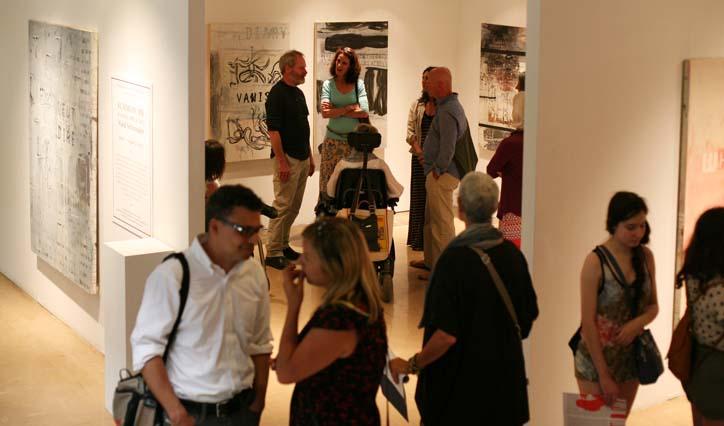
Ward Schumaker
Q: From the small, tightly organized wooden sculptures in your “Dumb Boxes” series to the large, exuberant paintings in the “Composers” series, noise and sound clearly inflects your work. How did music and sound come to figure so prominently in your work?
A: So much art and illustration today makes reference to pop music and if I were drawn to that music perhaps my paintings and illustration might share more similarities.

But my taste has centered on classical and serious modernist music; and at one point I decided to create a group of works in honor of some favorite composers: Janacek, Bach, Gavin Bryars, Shostakovich, Kurt Weill, Poulenc, Andriessen, among others. I think of the works as thank you notes.
Also, until a few years ago, I couldn’t paint without music. There was a decade of listening to Bach, another listening primarily to Weill and Janacek, and finally fifteen years dedicated to Shostakovich and Beethoven. Recently I’ve needed silence to work. I don’t know why.
Q: Your painting and hand lettering art takes many forms; what prompts you to shift from painting on canvas to creating one-off artist books, or collages in series, or sculptural pieces?
A: Ten years ago, my wife (artist Vivienne Flesher) and I took a class at the San Francisco Center for the Book in creating paste-papers (endpapers for books). I pushed the medium by creating large hand-painted books. Later, a gallerist from Shanghai saw some of the pages hanging on the wall to dry and offered to show them as paintings. Then George Lawson suggested mounting the pages on wood, doing away the need for frames and that led to painting on canvas. The sculptures came about separately: in preparation for a year’s visit to New York, I’d taken things to the basement for storage and discovered remnants from my life in the 60s, reminding me of cardboard sculptures I’d created in my first apartment. I decided to remake them in wood, and paint them with what I’d learned in the intervening years. Now I move from one to the other, as I feel the need.
Q: When did you first bring hand lettering into your paintings—was this a natural progression from book arts projects to paintings on canvas or wood?
A: I’ve used words in my work since college (the early 60s). My professors warned me not to, words were ‘non-visual’ in their thinking; but I pointed to a vast library of sacred illustrated manuscripts filled with hand-lettering and continued to include text in my work. As a consequence, I got lower grades. And my teachers’ warnings proved prescient: the next year, I was threatened with arrest for creating pornography when officials misunderstood my painting of one figure with a word balloon blossoming from its mouth as three figures—a femur confused for a male organ and mushy calligraphy for a woman’s privates. (Ironically, the words, in German, read: “Nothing can happen to me.”) Still, calligraphy became one of the few ways I’ve been privileged to share my personal work with what I do as an illustrator. In illustration, however, I’m careful to make the words legible.

Q: When you get a series going, of small paintings or collages, do you work exclusively with that material until you realize an end point, or do move between different art making activities? When do you know that a series is complete?
A: I work on a series until I feel satiated, until the Voice that tells me what to paint informs me it’s time to move on to something else. I don’t move back-and-forth between projects, although I frequently work on many pieces within one group at the same time, limited by the size of my studio. Lately that same Voice has been saying: time to make a big change. But I don’t yet understand what that entails.
Q: The titles of your works seem to be replies, in a sense, to questions the viewer can’t hear being asked. Could you expand on this: why titles are important, and what is the impulse for incorporating visible thinking in your art? And “Big Heaven” seems to be a recurring theme through different media—could you comment on this?
A: As for titles: I have little control over them––something inside tells me which words to use––but I feel I intuitively understand. Still, I’m probably fooling myself because I‘d be hard pressed to explain any of them. As for Big Heaven: I’ve meditated twenty minutes per day for forty years (with months off for bad behavior). About the time of my first show in Shanghai, I was also doing a daily one-hour walking meditation. It made me feel insanely high! (Art, meditation and insanity seem closely related to me.) At some point the words “I Am Big Heaven” came to define that high, that exhilaration, and I used it in a hand-painted book (now owned by artist Eric Fischl) and a number of paintings. Recently it covered one of my ‘dumb box’ sculptures (now owned by news commentator RachelMaddow). I go through life trying to recapture what seems like the larger knowledge of I Am Big Heaven, but it’s elusive. Which is unfortunate. Because it did, truly, feel like paradise. Of course paradise, on this planet, is evanescent; isn’t it?
Summon Me! Paintings by Ward Schumaker continues through August 25 at the San Marco Gallery of the Dominican University of California, Santa Rafael.
No comments:
Post a Comment